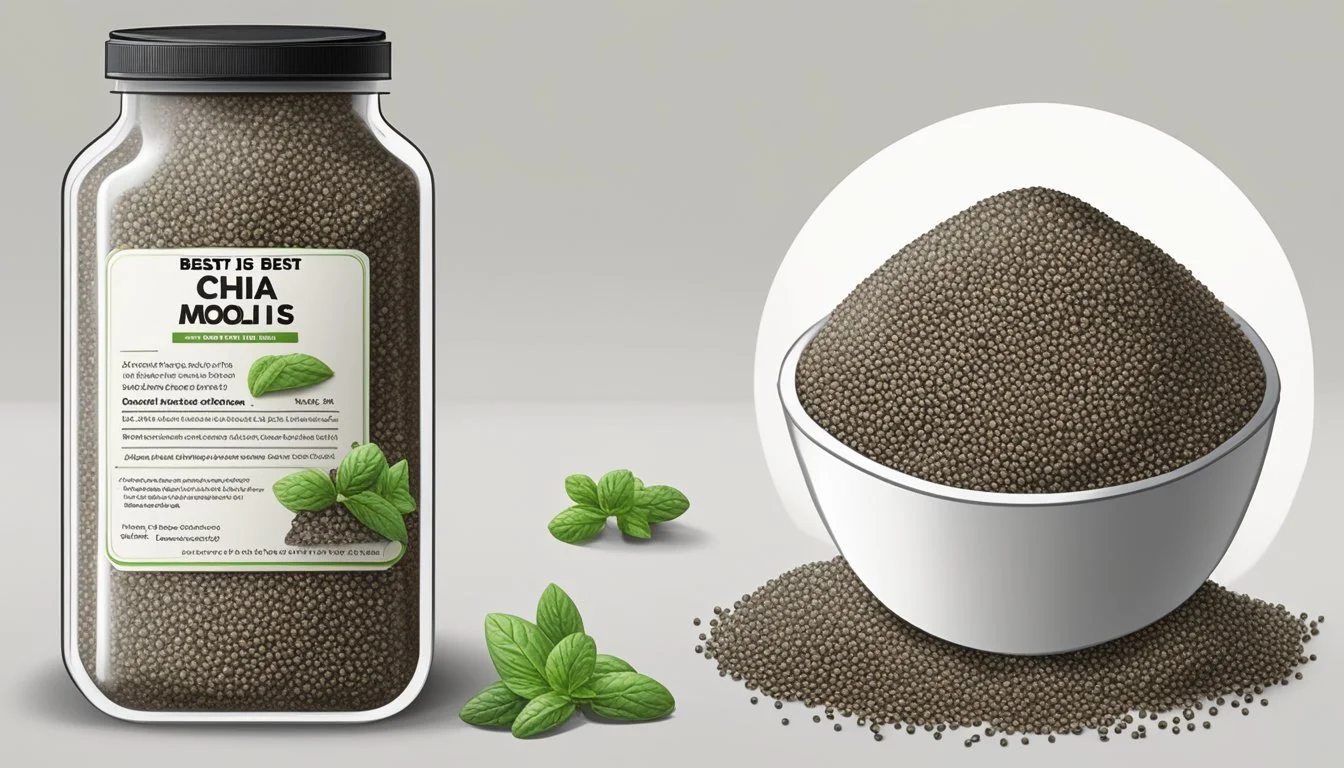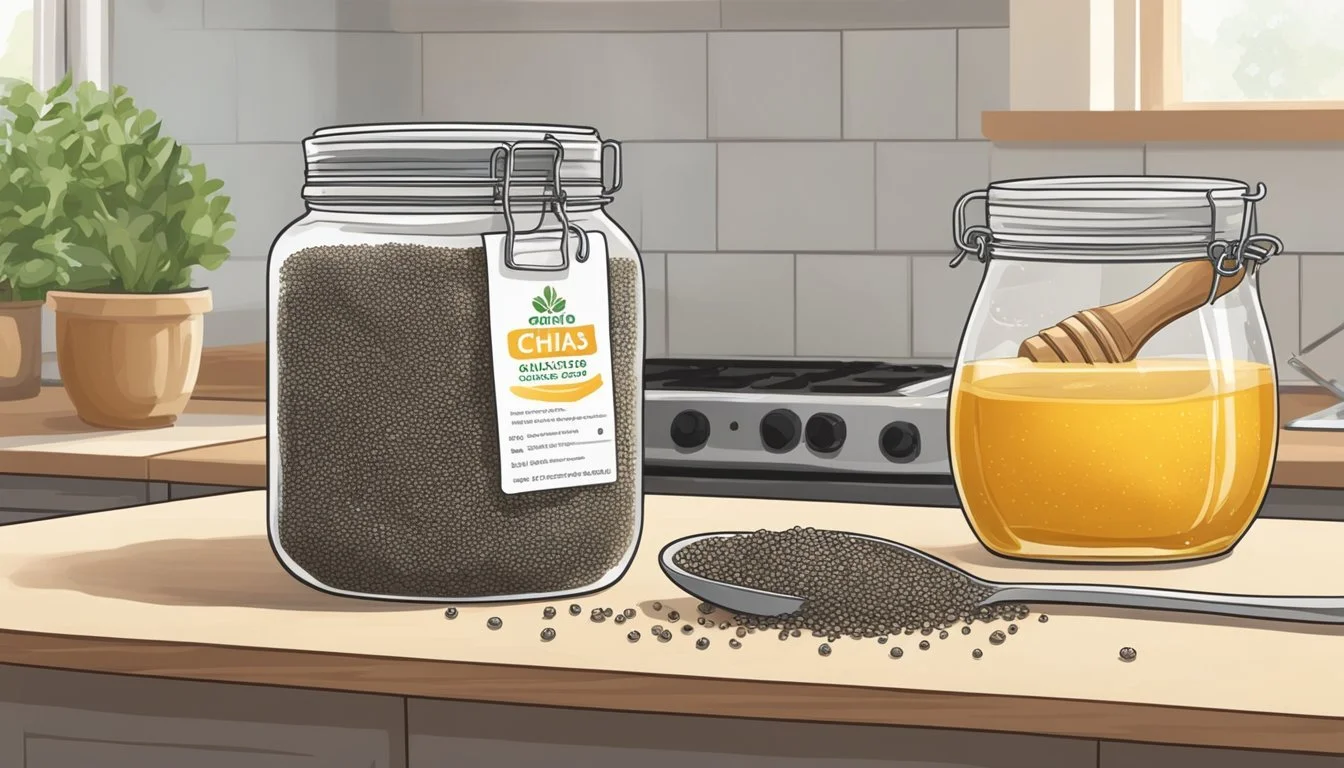Does Chia Seeds Go Bad?
Shelf Life and Storage Tips
Chia seeds have surged in popularity due to their impressive nutritional profile and versatility in various culinary applications. These tiny seeds, packed with fiber, omega-3 fatty acids, and essential nutrients, make a great addition to smoothies, salads, and baked goods.
Yes, chia seeds can go bad, despite their generally long shelf life ranging from 2 to 4 years. Proper storage in an airtight container away from heat and moisture is vital to keep them fresh. Signs of spoilage include discoloration, mold, and a rancid smell or taste.
The health benefits of chia seeds are widely recognized, but ensuring their freshness is key to fully enjoying these benefits. Don't consume chia seeds that show any signs of becoming rancid or developing mold, as this could pose health risks. Keep your chia seeds fresh and safe to ensure you maximize their nutritional value and health benefits.
Understanding Chia Seeds
Chia seeds are tiny, nutrient-dense seeds that come from the plant Salvia hispanica, native to Central America. Known for their impressive nutritional profile, these seeds have become a popular addition to various diets.
Nutrients:
Fiber: Chia seeds are an excellent source of dietary fiber. A single ounce (28 grams) contains about 10 grams of fiber.
Protein: They provide about 4 grams of protein per ounce. This makes them a good plant-based protein option.
Omega-3 Fatty Acids: Chia seeds are rich in alpha-linolenic acid (ALA), a type of omega-3 fatty acid. This essential nutrient supports heart health.
Antioxidants: High levels of antioxidants in chia seeds help combat oxidative stress in the body.
Minerals:
Calcium: One ounce of chia seeds contains about 18% of the recommended daily intake (RDI) of calcium, which supports bone health.
Iron: This same serving size offers around 12% of the RDI for iron, important for transporting oxygen in the blood.
Magnesium: Chia seeds also provide about 23% of the RDI for magnesium, crucial for muscle and nerve function.
Interest in chia seeds has surged due to their versatility and ease of use. They can be added to smoothies, yogurt, salads, and baked goods. Additionally, when soaked in liquid, they form a gel-like texture, making them a popular ingredient in puddings and as a vegan egg substitute.
Shelf Life and Freshness
Chia seeds are known for their durability and can last a long time if stored properly. Understanding the factors affecting their shelf life and recognizing signs of freshness can help make the most of their benefits.
Factors Affecting Shelf Life
The shelf life of chia seeds typically ranges from 2 to 5 years. This longevity depends on proper storage practices:
Airtight Containers: Storing chia seeds in airtight containers keeps out moisture and air, which can lead to spoilage.
Cool, Dry Places: Avoiding warmth and humidity is crucial. Ideally, keep chia seeds in a pantry or cupboard away from heat sources.
Refrigeration and Freezing: For prolonged storage, refrigeration or freezing can help extend their freshness.
Keep in mind, while chia seeds tend to have a best-by date, it is not an expiration date. Chia seeds are generally good beyond this date if stored correctly.
Signs of Fresh Chia Seeds
Fresh chia seeds have certain characteristics that distinguish them from their spoiled counterparts.
Color: They should be uniform in color, typically black or white. Any signs of discoloration may indicate spoilage.
Smell: Fresh chia seeds should be odorless. A rancid, off-putting smell is a clear sign that they have gone bad.
Texture and Taste: When tasted, fresh chia seeds should have a mild, nutty flavor. If they taste bitter or off, it’s time to discard them.
By keeping an eye on these features, one can ensure that their chia seeds remain fresh and safe to consume for as long as possible.
Proper Storage Methods
To maximize the shelf life and maintain the freshness of chia seeds, the key is proper storage. Effective techniques depend on whether you store them at room temperature or in colder environments such as the refrigerator or freezer.
Storing at Room Temperature
Chia seeds can be stored at room temperature for an extended period without losing their quality, provided they are kept in an airtight container. A mason jar with a tight seal works well.
Store the seeds in a cool, dry place away from sunlight. A cabinet or pantry is ideal. Moisture is the enemy of chia seeds, so ensuring that they remain dry is crucial.
Monitor the seeds for any signs of spoilage such as discoloration or a rancid smell. Both indicate that the seeds should no longer be consumed.
Refrigeration and Freezing Options
Refrigerating or freezing chia seeds can significantly extend their shelf life. When stored in the fridge, chia seeds can remain fresh for up to four years.
Use a sealed container to prevent any moisture from seeping in. A mason jar or a vacuum-sealed bag is suitable.
For long-term storage, the freezer is an excellent choice. Frozen chia seeds can stay fresh beyond four years. Ensure they are kept in a dark place within the freezer to avoid light exposure, which can degrade the seeds over time.
Regularly check for any signs of ice crystals or moisture, as these can indicate potential spoilage.
By implementing these storage methods, the shelf life of chia seeds can be maximized while retaining their nutritional value and quality.
Detecting Spoilage
Identifying if chia seeds have gone bad is crucial for maintaining their nutritional benefits and avoiding health risks. Spoiled chia seeds can exhibit various physical changes, and alterations in smell and taste.
Physical Changes
Chia seeds should maintain a uniform dark color. Discoloration is a clear sign of spoilage. If the seeds appear lighter or have unusual spots, they may be expired. Clumping is another indicator. Fresh chia seeds should flow freely, but moisture can cause them to stick together. Mold is a serious issue. Any fuzzy growth on the seeds should prompt immediate disposal. Another red flag is a slimy texture, which signals that the seeds have absorbed moisture and gone bad.
Smell and Taste
Fresh chia seeds have a mild nutty aroma. A rancid smell suggests the oils in the seeds have spoiled. If the seeds emit a foul odor, it's best to discard them. Taste also plays a critical role. Fresh chia seeds taste slightly nutty, while spoiled seeds can taste bitter or sour. If the seeds have an off or bitter taste, they should be thrown away to prevent any potential health issues.
Health Implications of Spoiled Chia Seeds
Consuming spoiled chia seeds can pose significant health risks.
One primary concern is food poisoning. Spoiled seeds may harbor harmful bacteria, leading to digestive discomfort, nausea, and vomiting. In severe cases, food poisoning can result in more critical health conditions.
Rancid chia seeds have an off-putting bitter taste. This bitterness indicates that the oils within the seeds have deteriorated. Eating these rancid seeds can negatively impact digestive health and might lead to digestive discomfort.
Mold growth on chia seeds is a clear indicator that they are unsafe to eat. Mold spores can produce toxins that are harmful when ingested, potentially leading to severe health issues.
It's worth noting that chia seeds, in their fresh form, offer numerous health benefits including improved heart health due to their high omega-3 content. Consuming spoiled seeds, however, negates these benefits and instead introduces risks.
Additionally, for individuals with low blood pressure, consuming spoiled chia seeds could exacerbate their condition. The quality of the seeds impacts their nutritional value and can influence health conditions like heart disease.
To ensure food safety, always store chia seeds in an airtight container away from heat and moisture. Regularly check for signs of spoilage such as a rancid smell, clumping, discoloration, or mold.
Incorporating Chia Seeds into Your Diet
Adding chia seeds to your diet can be effortless and beneficial, thanks to their versatility and nutrient density. They can be integrated into a variety of recipes and offer numerous health benefits when consumed regularly.
Recipes and Ideas
One simple way to include chia seeds is to make chia water. Soak a quarter cup of chia seeds in four cups of water for 20-30 minutes until they form a gel-like consistency. This chia gel can be added to any drink.
Chia pudding is another favorite. Mix 3 tablespoons of chia seeds with one cup of milk (dairy or plant-based) and let it sit overnight. Sweeten with honey or maple syrup and add fruits for flavor.
They can also be added to yogurt, where a tablespoon or two can provide extra crunch and nutrition. Similarly, when preparing a smoothie, just blend in a tablespoon of chia seeds.
For breakfast lovers, mix a spoonful into your cereal or oatmeal. Overnight oats with chia seeds combine both methods, creating a nutritious meal by morning. Lastly, a sprinkle on salads enhances their texture and nutritional value.
Benefits of Regular Consumption
Incorporating chia seeds into your daily diet brings several benefits. They are rich in omega-3 fatty acids, which are crucial for heart health. The high fiber content aids digestion and helps maintain a feeling of fullness, which is useful for those aiming for weight loss.
Chia seeds are an excellent source of protein. This is particularly beneficial for those following a vegan diet, as chia seeds contain all nine essential amino acids.
Regular consumption can help stabilize blood sugar levels due to their high protein and fiber content. The presence of various vitamins and minerals like calcium, iron, and magnesium contributes to overall health.
Chia seeds offer an affordable, easy way to boost nutrient intake, making them a valuable addition to anyone's diet.
Preventing Waste
Ensuring that chia seeds are not wasted involves buying the appropriate amount and finding inventive ways to use seeds that are approaching their expiration date. By adopting these strategies, one can minimize waste and maximize the utility of chia seeds.
Buying the Right Amount
Purchasing chia seeds in quantities that match usage needs helps prevent waste. Bulk buying may seem cost-effective, but if the seeds are not used promptly, they might go bad. Assessing consumption rate is crucial.
Consumers should check expiration dates and calculate how long it will take to use the seeds. It's recommended to store chia seeds in airtight containers in cool, dark places to extend shelf life. Avoiding exposure to heat, light, and moisture is essential to keep them safe to eat.
Creative Uses for Near-Expiry Seeds
When chia seeds near their expiration date, they can still be used in various creative ways. Incorporating them into baked goods like muffins and breads is an excellent option. Adding them to smoothies or yogurt provides a nutritional boost.
For a different approach, chia seeds can be used to make homemade granola bars or energy bites. They act as a binding agent and add texture. Integrating them into salads or soups is another way to avoid waste and enjoy their nutritional benefits.
Experimenting with these methods ensures that chia seeds are used fully, preventing unnecessary waste and maximizing their potential before they are no longer safe to consume.







